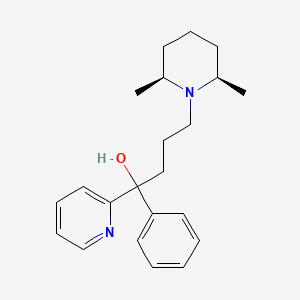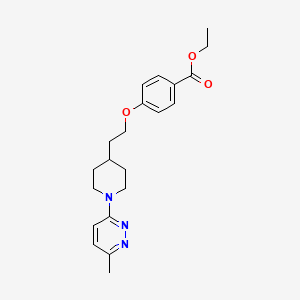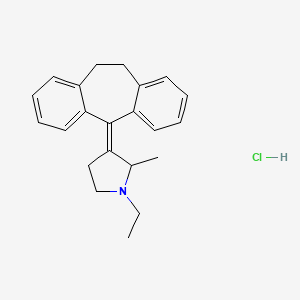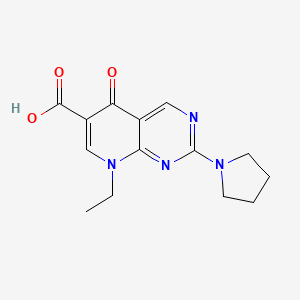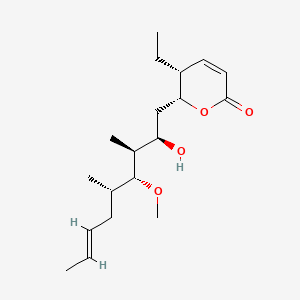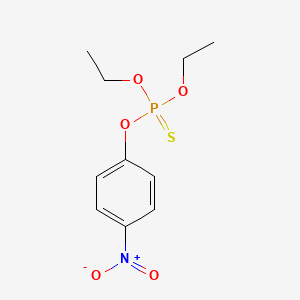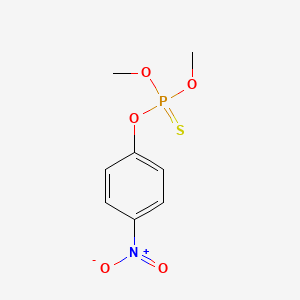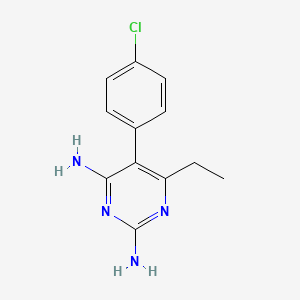
Pyrimethamine
Vue d'ensemble
Description
Pyrimethamine is a synthetic compound that belongs to the class of folic acid antagonists. It is primarily used as an antiparasitic agent to treat and prevent diseases such as toxoplasmosis and malaria. This compound works by inhibiting the enzyme dihydrofolate reductase, which is crucial for the synthesis of tetrahydrofolic acid, an essential component for DNA and RNA synthesis in many organisms .
Mécanisme D'action
Target of Action
Pyrimethamine primarily targets the enzyme dihydrofolate reductase (DHFR) of plasmodia . DHFR plays a crucial role in the biosynthesis of purines and pyrimidines, which are essential for DNA synthesis and cell multiplication .
Mode of Action
This compound acts as a folic acid antagonist . It inhibits the DHFR of plasmodia, thereby blocking the biosynthesis of purines and pyrimidines . This inhibition leads to the failure of nuclear division at the time of schizont formation in erythrocytes and liver .
Biochemical Pathways
The action of this compound is centered around the folate biochemical pathway . By inhibiting DHFR, this compound disrupts the conversion of dihydrofolate to tetrahydrofolate, a crucial step in the folate pathway . This disruption affects the synthesis of DNA, as tetrahydrofolate is a vital cofactor in the production of nucleic acids .
Pharmacokinetics
This compound is well-absorbed after oral administration . It has a protein binding of 87% and is metabolized in the liver . The elimination half-life of this compound is approximately 96 hours, and it is excreted through the kidneys .
Result of Action
The inhibition of DHFR by this compound leads to a failure in the synthesis of DNA, thereby preventing cell multiplication . This results in the arrest of the growth of plasmodia and Toxoplasma gondii, making this compound an effective antiparasitic compound .
Action Environment
The efficacy and stability of this compound can be influenced by environmental factors. For instance, the effectiveness of this compound as part of seasonal malaria chemoprevention (SMC) can vary based on the region and the level of resistance to the drug . Additionally, individual factors such as the patient’s health status and the presence of other medications can also impact the action of this compound .
Analyse Biochimique
Biochemical Properties
Pyrimethamine plays a crucial role in biochemical reactions by inhibiting the enzyme dihydrofolate reductase (DHFR). This inhibition blocks the biosynthesis of purines and pyrimidines, which are essential for DNA synthesis and cell multiplication . This compound’s interaction with DHFR is highly selective against plasmodia and Toxoplasma gondii, making it effective in treating infections caused by these parasites .
Cellular Effects
This compound has significant effects on various cell types and cellular processes. It induces cell senescence and boosts CD8+ T-cell mediated cytotoxicity in colorectal cancer cells . Additionally, it inhibits the growth of malaria parasites by causing failure of nuclear division during schizont formation in erythrocytes and liver cells . This compound also affects cell signaling pathways, such as the p38MAPK-p53 axis, which is involved in cellular senescence .
Molecular Mechanism
At the molecular level, this compound exerts its effects by binding to and inhibiting dihydrofolate reductase (DHFR). This inhibition prevents the conversion of dihydrofolate to tetrahydrofolate, a critical step in the synthesis of nucleic acids . The drug’s high affinity for the DHFR enzyme in parasites over mammalian cells ensures its selective toxicity . This compound also affects gene expression by blocking the synthesis of DNA and RNA .
Temporal Effects in Laboratory Settings
In laboratory settings, the effects of this compound can change over time. The drug’s stability and degradation are critical factors influencing its long-term effects on cellular function. Studies have shown that this compound remains stable and effective over extended periods, but its efficacy may decrease due to the development of drug resistance . Long-term exposure to this compound can lead to cellular adaptations, such as increased expression of drug efflux pumps .
Dosage Effects in Animal Models
The effects of this compound vary with different dosages in animal models. At therapeutic doses, this compound effectively treats parasitic infections without causing significant toxicity . At high doses, it can cause adverse effects such as bone marrow suppression, gastrointestinal upset, and severe allergic reactions . Threshold effects have been observed, where increasing the dosage beyond a certain point does not significantly enhance the drug’s efficacy but increases the risk of toxicity .
Metabolic Pathways
This compound is involved in metabolic pathways that include the inhibition of dihydrofolate reductase (DHFR), leading to the blockade of purine and pyrimidine biosynthesis . This inhibition disrupts the production of nucleic acids, essential for DNA and RNA synthesis . This compound’s interaction with DHFR is a key factor in its antiparasitic activity .
Transport and Distribution
Within cells and tissues, this compound is transported and distributed through various mechanisms. It is well-absorbed and has a high protein-binding capacity, which influences its distribution in the body . This compound interacts with transport proteins, such as the multidrug and toxin extrusion (MATE) transporters, which play a role in its renal elimination . The drug’s distribution is also affected by its affinity for specific tissues, such as the liver and erythrocytes .
Subcellular Localization
This compound’s subcellular localization is primarily within the cytoplasm, where it exerts its inhibitory effects on dihydrofolate reductase (DHFR) . The drug’s localization is influenced by its chemical structure and the presence of targeting signals that direct it to specific cellular compartments . This compound’s activity is closely linked to its ability to reach and inhibit DHFR within the cytoplasm .
Méthodes De Préparation
Synthetic Routes and Reaction Conditions: Pyrimethamine can be synthesized through a multi-step process involving the condensation of 4-chlorobenzaldehyde with ethyl acetoacetate to form 4-chlorocinnamic acid. This intermediate is then cyclized with guanidine to produce this compound .
Industrial Production Methods: In industrial settings, this compound is produced using high-pressure homogenization and nanoprecipitation techniques to improve its bioavailability and pharmacokinetic profile . These methods ensure the production of stable nanosuspensions with submicron particle sizes, enhancing the drug’s dissolution rate and therapeutic efficacy.
Analyse Des Réactions Chimiques
Types of Reactions: Pyrimethamine undergoes various chemical reactions, including:
Oxidation: this compound can be oxidized to form different metabolites.
Reduction: The compound can be reduced under specific conditions to yield different derivatives.
Substitution: this compound can undergo substitution reactions, particularly at the aromatic ring, to form various analogs.
Common Reagents and Conditions:
Oxidation: Common oxidizing agents include potassium permanganate and hydrogen peroxide.
Reduction: Reducing agents such as sodium borohydride and lithium aluminum hydride are used.
Substitution: Halogenating agents like chlorine and bromine are often employed.
Major Products: The major products formed from these reactions include various this compound derivatives with altered pharmacological properties .
Applications De Recherche Scientifique
Pyrimethamine has a wide range of scientific research applications:
Comparaison Avec Des Composés Similaires
Trimethoprim: Like pyrimethamine, trimethoprim inhibits dihydrofolate reductase but is primarily used to treat bacterial infections.
Methotrexate: This compound also inhibits dihydrofolate reductase and is used in cancer therapy and autoimmune diseases.
Cycloguanil: A derivative of proguanil, cycloguanil is another antimalarial drug that targets dihydrofolate reductase.
Uniqueness: this compound is unique in its high selectivity for protozoal dihydrofolate reductase, making it particularly effective against parasitic infections. Its ability to be used in combination with other drugs, such as sulfadiazine, enhances its therapeutic efficacy and reduces the likelihood of resistance development .
Propriétés
IUPAC Name |
5-(4-chlorophenyl)-6-ethylpyrimidine-2,4-diamine | |
|---|---|---|
| Source | PubChem | |
| URL | https://pubchem.ncbi.nlm.nih.gov | |
| Description | Data deposited in or computed by PubChem | |
InChI |
InChI=1S/C12H13ClN4/c1-2-9-10(11(14)17-12(15)16-9)7-3-5-8(13)6-4-7/h3-6H,2H2,1H3,(H4,14,15,16,17) | |
| Source | PubChem | |
| URL | https://pubchem.ncbi.nlm.nih.gov | |
| Description | Data deposited in or computed by PubChem | |
InChI Key |
WKSAUQYGYAYLPV-UHFFFAOYSA-N | |
| Source | PubChem | |
| URL | https://pubchem.ncbi.nlm.nih.gov | |
| Description | Data deposited in or computed by PubChem | |
Canonical SMILES |
CCC1=C(C(=NC(=N1)N)N)C2=CC=C(C=C2)Cl | |
| Source | PubChem | |
| URL | https://pubchem.ncbi.nlm.nih.gov | |
| Description | Data deposited in or computed by PubChem | |
Molecular Formula |
C12H13ClN4 | |
| Record name | PYRIMETHAMINE | |
| Source | CAMEO Chemicals | |
| URL | https://cameochemicals.noaa.gov/chemical/20974 | |
| Description | CAMEO Chemicals is a chemical database designed for people who are involved in hazardous material incident response and planning. CAMEO Chemicals contains a library with thousands of datasheets containing response-related information and recommendations for hazardous materials that are commonly transported, used, or stored in the United States. CAMEO Chemicals was developed by the National Oceanic and Atmospheric Administration's Office of Response and Restoration in partnership with the Environmental Protection Agency's Office of Emergency Management. | |
| Explanation | CAMEO Chemicals and all other CAMEO products are available at no charge to those organizations and individuals (recipients) responsible for the safe handling of chemicals. However, some of the chemical data itself is subject to the copyright restrictions of the companies or organizations that provided the data. | |
| Source | PubChem | |
| URL | https://pubchem.ncbi.nlm.nih.gov | |
| Description | Data deposited in or computed by PubChem | |
DSSTOX Substance ID |
DTXSID9021217 | |
| Record name | Pyrimethamine | |
| Source | EPA DSSTox | |
| URL | https://comptox.epa.gov/dashboard/DTXSID9021217 | |
| Description | DSSTox provides a high quality public chemistry resource for supporting improved predictive toxicology. | |
Molecular Weight |
248.71 g/mol | |
| Source | PubChem | |
| URL | https://pubchem.ncbi.nlm.nih.gov | |
| Description | Data deposited in or computed by PubChem | |
Physical Description |
Pyrimethamine is an odorless white crystalline powder. Tasteless. An antimalarial drug., Solid | |
| Record name | PYRIMETHAMINE | |
| Source | CAMEO Chemicals | |
| URL | https://cameochemicals.noaa.gov/chemical/20974 | |
| Description | CAMEO Chemicals is a chemical database designed for people who are involved in hazardous material incident response and planning. CAMEO Chemicals contains a library with thousands of datasheets containing response-related information and recommendations for hazardous materials that are commonly transported, used, or stored in the United States. CAMEO Chemicals was developed by the National Oceanic and Atmospheric Administration's Office of Response and Restoration in partnership with the Environmental Protection Agency's Office of Emergency Management. | |
| Explanation | CAMEO Chemicals and all other CAMEO products are available at no charge to those organizations and individuals (recipients) responsible for the safe handling of chemicals. However, some of the chemical data itself is subject to the copyright restrictions of the companies or organizations that provided the data. | |
| Record name | Pyrimethamine | |
| Source | Human Metabolome Database (HMDB) | |
| URL | http://www.hmdb.ca/metabolites/HMDB0014350 | |
| Description | The Human Metabolome Database (HMDB) is a freely available electronic database containing detailed information about small molecule metabolites found in the human body. | |
| Explanation | HMDB is offered to the public as a freely available resource. Use and re-distribution of the data, in whole or in part, for commercial purposes requires explicit permission of the authors and explicit acknowledgment of the source material (HMDB) and the original publication (see the HMDB citing page). We ask that users who download significant portions of the database cite the HMDB paper in any resulting publications. | |
Solubility |
>37.3 [ug/mL] (The mean of the results at pH 7.4), less than 0.1 mg/mL at 70 °F (NTP, 1992), In water, 10 mg/L (temperature not specified), Practically insoluble in water; slightly soluble in ethanol (about 9 g/L), in dilute HCl (about 5 g/L); soluble in boiling ethanol (about 25 g/L); Very sparingly soluble in propylene glycol and dimethylacetamide at 70 °C, 1.79e-01 g/L | |
| Record name | SID56422411 | |
| Source | Burnham Center for Chemical Genomics | |
| URL | https://pubchem.ncbi.nlm.nih.gov/bioassay/1996#section=Data-Table | |
| Description | Aqueous solubility in buffer at pH 7.4 | |
| Record name | PYRIMETHAMINE | |
| Source | CAMEO Chemicals | |
| URL | https://cameochemicals.noaa.gov/chemical/20974 | |
| Description | CAMEO Chemicals is a chemical database designed for people who are involved in hazardous material incident response and planning. CAMEO Chemicals contains a library with thousands of datasheets containing response-related information and recommendations for hazardous materials that are commonly transported, used, or stored in the United States. CAMEO Chemicals was developed by the National Oceanic and Atmospheric Administration's Office of Response and Restoration in partnership with the Environmental Protection Agency's Office of Emergency Management. | |
| Explanation | CAMEO Chemicals and all other CAMEO products are available at no charge to those organizations and individuals (recipients) responsible for the safe handling of chemicals. However, some of the chemical data itself is subject to the copyright restrictions of the companies or organizations that provided the data. | |
| Record name | Pyrimethamine | |
| Source | DrugBank | |
| URL | https://www.drugbank.ca/drugs/DB00205 | |
| Description | The DrugBank database is a unique bioinformatics and cheminformatics resource that combines detailed drug (i.e. chemical, pharmacological and pharmaceutical) data with comprehensive drug target (i.e. sequence, structure, and pathway) information. | |
| Explanation | Creative Common's Attribution-NonCommercial 4.0 International License (http://creativecommons.org/licenses/by-nc/4.0/legalcode) | |
| Record name | Pyrimethamine | |
| Source | Hazardous Substances Data Bank (HSDB) | |
| URL | https://pubchem.ncbi.nlm.nih.gov/source/hsdb/8042 | |
| Description | The Hazardous Substances Data Bank (HSDB) is a toxicology database that focuses on the toxicology of potentially hazardous chemicals. It provides information on human exposure, industrial hygiene, emergency handling procedures, environmental fate, regulatory requirements, nanomaterials, and related areas. The information in HSDB has been assessed by a Scientific Review Panel. | |
| Record name | Pyrimethamine | |
| Source | Human Metabolome Database (HMDB) | |
| URL | http://www.hmdb.ca/metabolites/HMDB0014350 | |
| Description | The Human Metabolome Database (HMDB) is a freely available electronic database containing detailed information about small molecule metabolites found in the human body. | |
| Explanation | HMDB is offered to the public as a freely available resource. Use and re-distribution of the data, in whole or in part, for commercial purposes requires explicit permission of the authors and explicit acknowledgment of the source material (HMDB) and the original publication (see the HMDB citing page). We ask that users who download significant portions of the database cite the HMDB paper in any resulting publications. | |
Mechanism of Action |
Pyrimethamine inhibits the dihydrofolate reductase of plasmodia and thereby blocks the biosynthesis of purines and pyrimidines, which are essential for DNA synthesis and cell multiplication. This leads to failure of nuclear division at the time of schizont formation in erythrocytes and liver., Pyrimethamine is an antimalarial drug that has also been used successfully to treat autoimmune diseases such as lymphoproliferative syndrome. In this work, the effect of pyrimethamine (PYR) on the production of free radicals in malaria-infected mice was studied to better understand the drug's immunomodulatory properties. BALB/c and CBA/Ca mice were infected with Plasmodium yoelii 17XL. Seven days after infection, mice were treated with PYR or vehicle and sacrificed 24h later. Treatment with PYR increased superoxide dismutase and glutathione peroxidase activities in erythrocytes and the liver, augmented the levels of nitric oxide in the serum, and upregulated mRNA levels of superoxide dismutase, glutathione peroxidase, catalase, and iNOS in the spleen. In addition, PYR increased lipoperoxidation and protein carbonylation in infected mice. Our results indicate that P. yoelii 17XL reduces oxidative stress in infected cells, while PYR induces it, which is associated with increased parasite elimination. Thus, it is possible that oxidative stress generated by pyrimethamine is also involved in its immunomodulatory mechanism of action., Co-infection of human immunodeficiency virus (HIV) with malaria is one of the pandemic problems in Africa and parts of Asia. Here we investigated the impact of pyrimethamine (PYR) and two other clinical anti-malarial drugs (chloroquine [CQ] or artemisinin [ART]) on HIV-1 replication. Peripheral blood mononuclear cells (PBMCs) or MT-2 cells were infected with HIV(NL4.3) strain and treated with different concentrations of the anti-malarial drugs. HIV-1 replication was measured using p24 ELISA. We show that 10 uM CQ and ART inhibited HIV-1 replication by 76% and 60% in PBMCs, respectively, but not in MT-2 cells. In contrast, 10 uM PYR enhanced HIV-1 replication in MT-2 cells by >10-fold. A series of molecular mechanism studies revealed that PYR increased intracellular HIV gag proteins without affecting the promoter or the reverse transcriptase activity. The effect of PYR was independent of HTLV-1 produced by MT-2 cells. Of interest, PYR treatment led to S-phase accumulation and increased AZT and d4T antiviral activity by ~ 4-fold. Taken together, we show that PYR significantly enhances HIV-1 replication by affecting the cellular machinery. Our results could be relevant for the management of malaria and HIV particularly in regions where HIV-1 and malaria epidemics overlap., Autosomal dominant polycystic kidney disease (ADPKD) is a commonly inherited disorder mostly caused by mutations in PKD1, encoding polycystin-1 (PC1). The disease is characterized by development and growth of epithelium-lined cyst in both kidneys, often leading to renal failure. There is no specific treatment for this disease. Here, we report a sustained activation of the transcription factor signal transducer and activator of transcription 3 (STAT3) in ischemic injured and uninjured Pkd1 knockout polycystic kidneys and in human ADPKD kidneys. Through a chemical library screen, we identified the anti-parasitic compound pyrimethamine as an inhibitor of STAT3 function. Treatment with pyrimethamine decreases cell proliferation in human ADPKD cells and blocks renal cyst formation in an adult and a neonatal PKD mouse model. Moreover, we demonstrated that a specific STAT3 inhibitor, S3I-201, reduces cyst formation and growth in a neonatal PKD mouse model. Our results suggest that PC1 acts as a negative regulator of STAT3 and that blocking STAT3 signaling with pyrimethamine or similar drugs may be an attractive therapy for human ADPKD., The unresponsiveness of metastatic melanoma to conventional chemotherapeutic and biological agents is largely due to the development of resistance to apoptosis. Pyrimethamine belongs to the group of antifolate drugs, and in addition to antiprotozoan effects, it exerts a strong proapoptotic activity, which we recently characterized in human T lymphocytes. However, no data regarding pyrimethamine anticancer activity are available thus far. To this end, we examined the in vitro effects of pyrimethamine on apoptosis, cell cycle distribution, and cell proliferation of human metastatic melanoma cell lines. The in vivo antitumor potential of pyrimethamine was evaluated in a severe combined immunodeficiency (SCID) mouse xenotransplantation model. Our data indicate that pyrimethamine, when used at a clinically relevant concentration, induced apoptosis in metastatic melanoma cells via the activation of the cathepsin B and the caspase cascade (i.e., caspase-8 and caspase-9) and subsequent mitochondrial depolarization. This occurred independently from CD95/Fas engagement. Moreover, pyrimethamine induced a marked inhibition of cell growth and an S-phase cell cycle arrest. Results obtained in SCID mice, injected s.c. with metastatic melanoma cells and treated with pyrimethamine, indicated a significant inhibitory effect on tumor growth. In conclusion, our results suggest that pyrimethamine-induced apoptosis may be considered as a multifaceted process, in which different inducers or regulators of apoptosis are simultaneously implicated, thus permitting death defects of melanoma cells to be bypassed or overcome. On these bases, we hypothesize that pyrimethamine could represent an interesting candidate for the treatment of metastatic melanoma., Pyrimethamine is a folic acid antagonist and has a mechanism of action similar to that of trimethoprim. By binding to and reversibly inhibiting dihydrofolate reductase, pyrimethamine inhibits the reduction of dihydrofolic acid to tetrahydrofolic acid (folinic acid). Pyrimethamine interferes with the synthesis of tetrahydrofolic acid in malarial parasites at a point immediately succeeding that where sulfonamides act. Sulfadoxine, like other sulfonamides, is a structural analog of p-aminobenzoic acid (PABA) and competitively inhibits dihydrofolic acid synthesis which is necessary for the conversion of PABA to folic acid. The combination of sulfadoxine and pyrimethamine results in a synergistic action against susceptible plasmodia. | |
| Record name | Pyrimethamine | |
| Source | DrugBank | |
| URL | https://www.drugbank.ca/drugs/DB00205 | |
| Description | The DrugBank database is a unique bioinformatics and cheminformatics resource that combines detailed drug (i.e. chemical, pharmacological and pharmaceutical) data with comprehensive drug target (i.e. sequence, structure, and pathway) information. | |
| Explanation | Creative Common's Attribution-NonCommercial 4.0 International License (http://creativecommons.org/licenses/by-nc/4.0/legalcode) | |
| Record name | Pyrimethamine | |
| Source | Hazardous Substances Data Bank (HSDB) | |
| URL | https://pubchem.ncbi.nlm.nih.gov/source/hsdb/8042 | |
| Description | The Hazardous Substances Data Bank (HSDB) is a toxicology database that focuses on the toxicology of potentially hazardous chemicals. It provides information on human exposure, industrial hygiene, emergency handling procedures, environmental fate, regulatory requirements, nanomaterials, and related areas. The information in HSDB has been assessed by a Scientific Review Panel. | |
Color/Form |
Crystals, White scored tablets contains 25 mg pyrimethamine /Daraprim/ | |
CAS No. |
58-14-0 | |
| Record name | PYRIMETHAMINE | |
| Source | CAMEO Chemicals | |
| URL | https://cameochemicals.noaa.gov/chemical/20974 | |
| Description | CAMEO Chemicals is a chemical database designed for people who are involved in hazardous material incident response and planning. CAMEO Chemicals contains a library with thousands of datasheets containing response-related information and recommendations for hazardous materials that are commonly transported, used, or stored in the United States. CAMEO Chemicals was developed by the National Oceanic and Atmospheric Administration's Office of Response and Restoration in partnership with the Environmental Protection Agency's Office of Emergency Management. | |
| Explanation | CAMEO Chemicals and all other CAMEO products are available at no charge to those organizations and individuals (recipients) responsible for the safe handling of chemicals. However, some of the chemical data itself is subject to the copyright restrictions of the companies or organizations that provided the data. | |
| Record name | Pyrimethamine | |
| Source | CAS Common Chemistry | |
| URL | https://commonchemistry.cas.org/detail?cas_rn=58-14-0 | |
| Description | CAS Common Chemistry is an open community resource for accessing chemical information. Nearly 500,000 chemical substances from CAS REGISTRY cover areas of community interest, including common and frequently regulated chemicals, and those relevant to high school and undergraduate chemistry classes. This chemical information, curated by our expert scientists, is provided in alignment with our mission as a division of the American Chemical Society. | |
| Explanation | The data from CAS Common Chemistry is provided under a CC-BY-NC 4.0 license, unless otherwise stated. | |
| Record name | Pyrimethamine [USP:INN:BAN:JAN] | |
| Source | ChemIDplus | |
| URL | https://pubchem.ncbi.nlm.nih.gov/substance/?source=chemidplus&sourceid=0000058140 | |
| Description | ChemIDplus is a free, web search system that provides access to the structure and nomenclature authority files used for the identification of chemical substances cited in National Library of Medicine (NLM) databases, including the TOXNET system. | |
| Record name | Pyrimethamine | |
| Source | DrugBank | |
| URL | https://www.drugbank.ca/drugs/DB00205 | |
| Description | The DrugBank database is a unique bioinformatics and cheminformatics resource that combines detailed drug (i.e. chemical, pharmacological and pharmaceutical) data with comprehensive drug target (i.e. sequence, structure, and pathway) information. | |
| Explanation | Creative Common's Attribution-NonCommercial 4.0 International License (http://creativecommons.org/licenses/by-nc/4.0/legalcode) | |
| Record name | pyrimethamine | |
| Source | DTP/NCI | |
| URL | https://dtp.cancer.gov/dtpstandard/servlet/dwindex?searchtype=NSC&outputformat=html&searchlist=757306 | |
| Description | The NCI Development Therapeutics Program (DTP) provides services and resources to the academic and private-sector research communities worldwide to facilitate the discovery and development of new cancer therapeutic agents. | |
| Explanation | Unless otherwise indicated, all text within NCI products is free of copyright and may be reused without our permission. Credit the National Cancer Institute as the source. | |
| Record name | pyrimethamine | |
| Source | DTP/NCI | |
| URL | https://dtp.cancer.gov/dtpstandard/servlet/dwindex?searchtype=NSC&outputformat=html&searchlist=3061 | |
| Description | The NCI Development Therapeutics Program (DTP) provides services and resources to the academic and private-sector research communities worldwide to facilitate the discovery and development of new cancer therapeutic agents. | |
| Explanation | Unless otherwise indicated, all text within NCI products is free of copyright and may be reused without our permission. Credit the National Cancer Institute as the source. | |
| Record name | Pyrimethamine | |
| Source | EPA DSSTox | |
| URL | https://comptox.epa.gov/dashboard/DTXSID9021217 | |
| Description | DSSTox provides a high quality public chemistry resource for supporting improved predictive toxicology. | |
| Record name | Pyrimethamine | |
| Source | European Chemicals Agency (ECHA) | |
| URL | https://echa.europa.eu/substance-information/-/substanceinfo/100.000.331 | |
| Description | The European Chemicals Agency (ECHA) is an agency of the European Union which is the driving force among regulatory authorities in implementing the EU's groundbreaking chemicals legislation for the benefit of human health and the environment as well as for innovation and competitiveness. | |
| Explanation | Use of the information, documents and data from the ECHA website is subject to the terms and conditions of this Legal Notice, and subject to other binding limitations provided for under applicable law, the information, documents and data made available on the ECHA website may be reproduced, distributed and/or used, totally or in part, for non-commercial purposes provided that ECHA is acknowledged as the source: "Source: European Chemicals Agency, http://echa.europa.eu/". Such acknowledgement must be included in each copy of the material. ECHA permits and encourages organisations and individuals to create links to the ECHA website under the following cumulative conditions: Links can only be made to webpages that provide a link to the Legal Notice page. | |
| Record name | PYRIMETHAMINE | |
| Source | FDA Global Substance Registration System (GSRS) | |
| URL | https://gsrs.ncats.nih.gov/ginas/app/beta/substances/Z3614QOX8W | |
| Description | The FDA Global Substance Registration System (GSRS) enables the efficient and accurate exchange of information on what substances are in regulated products. Instead of relying on names, which vary across regulatory domains, countries, and regions, the GSRS knowledge base makes it possible for substances to be defined by standardized, scientific descriptions. | |
| Explanation | Unless otherwise noted, the contents of the FDA website (www.fda.gov), both text and graphics, are not copyrighted. They are in the public domain and may be republished, reprinted and otherwise used freely by anyone without the need to obtain permission from FDA. Credit to the U.S. Food and Drug Administration as the source is appreciated but not required. | |
| Record name | Pyrimethamine | |
| Source | Hazardous Substances Data Bank (HSDB) | |
| URL | https://pubchem.ncbi.nlm.nih.gov/source/hsdb/8042 | |
| Description | The Hazardous Substances Data Bank (HSDB) is a toxicology database that focuses on the toxicology of potentially hazardous chemicals. It provides information on human exposure, industrial hygiene, emergency handling procedures, environmental fate, regulatory requirements, nanomaterials, and related areas. The information in HSDB has been assessed by a Scientific Review Panel. | |
| Record name | Pyrimethamine | |
| Source | Human Metabolome Database (HMDB) | |
| URL | http://www.hmdb.ca/metabolites/HMDB0014350 | |
| Description | The Human Metabolome Database (HMDB) is a freely available electronic database containing detailed information about small molecule metabolites found in the human body. | |
| Explanation | HMDB is offered to the public as a freely available resource. Use and re-distribution of the data, in whole or in part, for commercial purposes requires explicit permission of the authors and explicit acknowledgment of the source material (HMDB) and the original publication (see the HMDB citing page). We ask that users who download significant portions of the database cite the HMDB paper in any resulting publications. | |
Melting Point |
451 to 453 °F (capillary) (NTP, 1992), 233-234 °C (capillary); 240-242 °C (copper block), 233.5 °C | |
| Record name | PYRIMETHAMINE | |
| Source | CAMEO Chemicals | |
| URL | https://cameochemicals.noaa.gov/chemical/20974 | |
| Description | CAMEO Chemicals is a chemical database designed for people who are involved in hazardous material incident response and planning. CAMEO Chemicals contains a library with thousands of datasheets containing response-related information and recommendations for hazardous materials that are commonly transported, used, or stored in the United States. CAMEO Chemicals was developed by the National Oceanic and Atmospheric Administration's Office of Response and Restoration in partnership with the Environmental Protection Agency's Office of Emergency Management. | |
| Explanation | CAMEO Chemicals and all other CAMEO products are available at no charge to those organizations and individuals (recipients) responsible for the safe handling of chemicals. However, some of the chemical data itself is subject to the copyright restrictions of the companies or organizations that provided the data. | |
| Record name | Pyrimethamine | |
| Source | DrugBank | |
| URL | https://www.drugbank.ca/drugs/DB00205 | |
| Description | The DrugBank database is a unique bioinformatics and cheminformatics resource that combines detailed drug (i.e. chemical, pharmacological and pharmaceutical) data with comprehensive drug target (i.e. sequence, structure, and pathway) information. | |
| Explanation | Creative Common's Attribution-NonCommercial 4.0 International License (http://creativecommons.org/licenses/by-nc/4.0/legalcode) | |
| Record name | Pyrimethamine | |
| Source | Hazardous Substances Data Bank (HSDB) | |
| URL | https://pubchem.ncbi.nlm.nih.gov/source/hsdb/8042 | |
| Description | The Hazardous Substances Data Bank (HSDB) is a toxicology database that focuses on the toxicology of potentially hazardous chemicals. It provides information on human exposure, industrial hygiene, emergency handling procedures, environmental fate, regulatory requirements, nanomaterials, and related areas. The information in HSDB has been assessed by a Scientific Review Panel. | |
| Record name | Pyrimethamine | |
| Source | Human Metabolome Database (HMDB) | |
| URL | http://www.hmdb.ca/metabolites/HMDB0014350 | |
| Description | The Human Metabolome Database (HMDB) is a freely available electronic database containing detailed information about small molecule metabolites found in the human body. | |
| Explanation | HMDB is offered to the public as a freely available resource. Use and re-distribution of the data, in whole or in part, for commercial purposes requires explicit permission of the authors and explicit acknowledgment of the source material (HMDB) and the original publication (see the HMDB citing page). We ask that users who download significant portions of the database cite the HMDB paper in any resulting publications. | |
Retrosynthesis Analysis
AI-Powered Synthesis Planning: Our tool employs the Template_relevance Pistachio, Template_relevance Bkms_metabolic, Template_relevance Pistachio_ringbreaker, Template_relevance Reaxys, Template_relevance Reaxys_biocatalysis model, leveraging a vast database of chemical reactions to predict feasible synthetic routes.
One-Step Synthesis Focus: Specifically designed for one-step synthesis, it provides concise and direct routes for your target compounds, streamlining the synthesis process.
Accurate Predictions: Utilizing the extensive PISTACHIO, BKMS_METABOLIC, PISTACHIO_RINGBREAKER, REAXYS, REAXYS_BIOCATALYSIS database, our tool offers high-accuracy predictions, reflecting the latest in chemical research and data.
Strategy Settings
| Precursor scoring | Relevance Heuristic |
|---|---|
| Min. plausibility | 0.01 |
| Model | Template_relevance |
| Template Set | Pistachio/Bkms_metabolic/Pistachio_ringbreaker/Reaxys/Reaxys_biocatalysis |
| Top-N result to add to graph | 6 |
Feasible Synthetic Routes
A: Pyrimethamine acts as a potent and selective inhibitor of dihydrofolate reductase (DHFR) in protozoan parasites like Plasmodium falciparum (malaria) and Toxoplasma gondii (toxoplasmosis) [, , , ]. DHFR is a key enzyme in the folate metabolic pathway, essential for the synthesis of tetrahydrofolic acid, a coenzyme required for DNA, RNA, and protein synthesis. By inhibiting DHFR, this compound disrupts these vital processes, ultimately leading to parasite death [, , ].
A: While this compound inhibits DHFR in both parasites and humans, it exhibits a much higher affinity for the parasitic enzyme. This selective toxicity is attributed to structural differences between mammalian and parasitic DHFR enzymes [, ].
ANone: this compound has the molecular formula C12H13ClN4 and a molecular weight of 248.71 g/mol.
A: Yes, computational chemistry tools have been employed to study this compound's interactions with its target enzyme, DHFR []. These studies often involve molecular docking simulations to understand the binding mode and affinity of this compound and its analogs to DHFR.
A: Modifications to the this compound structure can significantly alter its activity, potency, and selectivity. For instance, the addition of specific functional groups can increase its lipophilicity, potentially enhancing its penetration into parasite cells []. Researchers have explored various structural analogs of this compound to improve its efficacy, overcome resistance, and reduce toxicity [, ].
A: The stability of this compound can be influenced by factors like pH, temperature, and exposure to light. While the research papers do not provide extensive data on its specific stability profile, they highlight that formulation strategies are essential for optimizing its delivery and efficacy [, ]. One common approach is to formulate this compound with sulfadoxine in a fixed-dose combination to enhance its antimalarial activity and delay resistance development [, , ].
A: Research indicates that this compound is well-absorbed after oral administration [, ]. It is widely distributed throughout the body, including tissues like the liver, lungs, and brain []. The metabolism of this compound is not fully elucidated, but studies suggest significant biliary excretion, with a portion of the drug and its metabolites eliminated in feces [, ].
A: this compound's in vitro activity is commonly assessed using cell-based assays that measure its ability to inhibit the growth of parasites like P. falciparum [, , ]. In vivo studies often employ animal models, such as mice infected with P. chabaudi, to evaluate the efficacy of this compound and its analogs in clearing parasitic infections [, ].
A: Yes, numerous clinical trials have been conducted to evaluate the effectiveness of this compound-containing regimens in treating malaria and toxoplasmosis [, , , , , ]. These trials typically assess clinical outcomes such as fever clearance time, parasite clearance time, and cure rates.
A: Resistance to this compound frequently arises from point mutations in the gene encoding the DHFR enzyme, particularly at codons 51, 59, and 108 [, , , , ]. These mutations reduce the binding affinity of this compound to DHFR, rendering it less effective [, ].
A: Yes, cross-resistance can occur between this compound and other antifolate drugs, such as cycloguanil (the active metabolite of proguanil) [, ]. This cross-resistance is often linked to shared mutations in the DHFR gene that affect the binding of both drugs.
A: The dissolution rate and solubility of this compound in various media play a crucial role in its bioavailability, which directly impacts its efficacy []. Understanding these properties is vital for optimizing its formulation and ensuring consistent drug release and absorption.
A: Rigorous analytical methods are employed to characterize, quantify, and monitor this compound in both raw material and finished pharmaceutical products [, , ]. These methods, often involving techniques like spectrophotometry or chromatography, undergo thorough validation to ensure their accuracy, precision, and specificity [, ]. Quality control measures are crucial throughout the development, manufacturing, and distribution of this compound-containing medications to guarantee their safety and effectiveness [].
A: Yes, alternative drugs or drug combinations exist for treating these parasitic infections. For instance, in areas where this compound resistance is prevalent, artemisinin-based combination therapies (ACTs) are recommended as the first-line treatment for malaria [, ]. Similarly, clindamycin, in combination with this compound, can be used as an alternative treatment for toxoplasmosis [, ].
Avertissement et informations sur les produits de recherche in vitro
Veuillez noter que tous les articles et informations sur les produits présentés sur BenchChem sont destinés uniquement à des fins informatives. Les produits disponibles à l'achat sur BenchChem sont spécifiquement conçus pour des études in vitro, qui sont réalisées en dehors des organismes vivants. Les études in vitro, dérivées du terme latin "in verre", impliquent des expériences réalisées dans des environnements de laboratoire contrôlés à l'aide de cellules ou de tissus. Il est important de noter que ces produits ne sont pas classés comme médicaments et n'ont pas reçu l'approbation de la FDA pour la prévention, le traitement ou la guérison de toute condition médicale, affection ou maladie. Nous devons souligner que toute forme d'introduction corporelle de ces produits chez les humains ou les animaux est strictement interdite par la loi. Il est essentiel de respecter ces directives pour assurer la conformité aux normes légales et éthiques en matière de recherche et d'expérimentation.



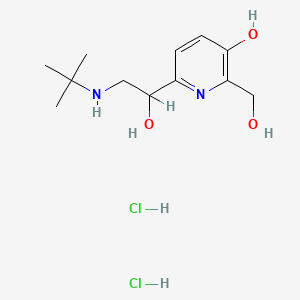
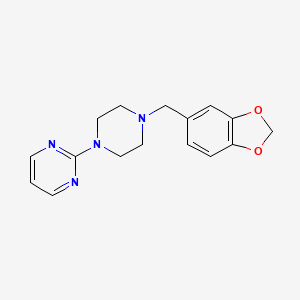
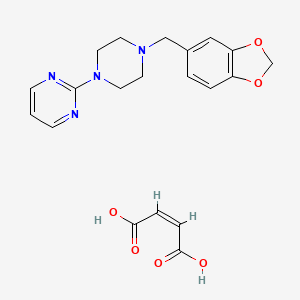
![[6-(HYDROXYMETHYL)-2-PYRIDYL]METHYL 2-(4-CHLOROPHENOXY)-2-METHYLPROPIONATE HYDROCHLORIDE](/img/structure/B1678449.png)


